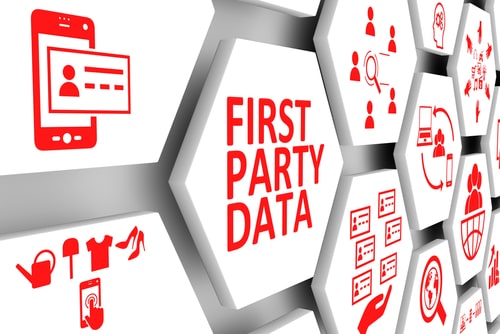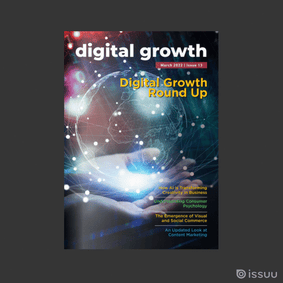Updated 2023.
With privacy concerns and regulatory laws being enforced across the globe, digital marketers are dealing with the loss of third-party cookies which has led to certain challenges. When the announcement was first made, marketers became anxious about how they were going to track and understand the buyer behaviours of their target markets, but it’s not all doom and gloom.
One thing marketers are good at is adjusting their processes and aligning their strategies with new and improved tactics. So today, marketers have no choice but to focus their efforts on a first-party data strategy.
In this article, we will take a look at the key differences between first and third-party data, unpack the benefits of focusing your marketing strategy on first-party data and look at some steps to creating a powerful first-party data marketing strategy.
Let’s dive right in…

What is the difference between first and third-party data?
There are three prominent types of data collection: First-party, second-party and third-party. In this article, we will be taking a look at the difference between first- and third-party as these are the prominent players in the digital marketing field.

What is first-party data?
First-party data collection is the way you obtain data directly from your sources, this means that you own this data. The data source is incredibly valuable as you get your information firsthand from the buyer and audience. This eliminates any chance of error or misunderstanding. Essentially, this is the most reliable and effective form of information collection.
There are a variety of ways to collect first-party data, the most common being:
- Social media
- Google analytics
- Website
- Customer surveys and feedback
- Customer Relationship Management systems
- Mobile Applications
- Call centres
- Online chatbots or AI chats
The kind of information you can collect from first-party data includes:
- Behaviour and interests
- Demographics
- Brand interaction
- Time spent on websites and websites visited
- Purchase history
First-party data is the most vital form of data and research actually proves that is the superior form of data collection. In fact, according to a survey completed by Winterberry Group, 36% of executives say increasing the quality of first-party data is crucial for brands. Forbes reported that 41% of high-performance marketers are using first-party data as part of their overarching marketing strategy and incorporating MarTech (specifically Customer Relationship Management systems) to support this process.
What is third-party data?
First-party data is collected from your own sources such as website lead generation forms while third-party lead generation is data obtained through online sources. It consists of purchasing information from other online sources such as Facebook.
Examples of third-party data collection include:
- Amazon
- Oracle Data Cloud
Due to security risks, this kind of data is no more, and as stated previously, this left marketers in a tizzy all over the world as it was the easiest way to collect data. However, the American Marketing Association has explained that third-party data is actually not as effective as we may think.
The report stated that third-party data is not accurate in its data collection and that there are more reliable ways to collect data - such as first-party data collection.
Below, we take a look at the benefits of first-party data collection and how you can use it to better your lead generation and marketing efforts.
The benefits of focusing your strategy on first-party data collection
First-party data is the most accurate data you can collect, it is owned, created by, and sourced from individual people directly and because of this, it is clean and unaltered information that can personalize and better all your inbound marketing efforts.
By collecting first-party data you are able to fully understand your individual leads and customers, meaning you are able to anticipate their needs. But it doesn't just end there, here are just a few benefits that come with a first-party data collection strategy.
- Personalization: By collecting data straight from the source you are able to get to know your individual customers. You are able to research what items they are browsing on your website and understand what subject interests them about your business. This kind of data empowers your marketing team to create personalized messages for your clients and build one-on-one relationships with each of them.
- GDPR Compliance: By using first-party data, that is data collected from your customers and leads themselves, you are following the right processes when it comes to information security, and gathering data legitimately should be your number one focus as a marketer.
- Meaningful Marketing: By understanding your individual leads and customers you are able to craft personalized marketing messages, reaching your lead at the right time, with the right message. This will build trust with your audience and show them that you care about their particular needs and wants.
- Accuracy: First-party data is the most accurate data collection as it is obtained through your customers and prospects, unlike third-party data that is aggregated through a variety of data sets. As this data comes from your audience it is also more relevant to your marketing and sales efforts - saving your marketers valuable time and resources by focusing their efforts on substantial and high-quality prospects, leads, and customers.
- Cost-effective: First-party is a cost-effective way to source data. Although it may take more time and effort, it is a significant cost cut. Third-party data collection is imprecise and aggregated into segments and doesn't offer thorough insights into individual customers -and as it is aggregated it costs more to source - but doesn't provide the rewards.
These are just a few of the benefits that come with a first-party data strategy. So, how do you begin implementing this across your marketing efforts?
Let’s take a look.
Steps to creating a powerful first-party data marketing strategy
Define your objectives
You may be implementing a first-party data strategy for, well, the first time but one thing that hasn't changed is your objective. Go back to basics and focus on what you want to do for your audience - are you offering an omnichannel experience or are you focused on providing real-time and more personalized marketing - or both? Are you wanting to retarget individuals who have shown interest in your business or do you want to understand certain audience behaviours? All of the above objectives can be improved through first-party data collection - and once you have those goals down you are able to begin crafting a first-party data collection campaign and strategy focused on your particular goals.
Define your customer and audience segments
Once you are able to define the customer lifecycle or buyer journey, you will be able to identify the key stages of visitor engagement. This will provide you with techniques on how to market to them at each stage of the cycle.
In order to fully define your audience and target them successfully, you will need the correct first-party data and you can gain this data through web, CRM, communication channels, and mobile - to name just a few. However, before personalization can begin you need to identify and segment your visitors into marketing groups.
You can segment these personas in demographics, affinities, lead quality, and online behaviours.
Data Collection Sources
It is now time to specify how your data and related channels can be combined to provide the best customer experience. There are a number of ways to understand your customers through data collection and this is not just limited to data points. It can be about how you are able to combine and enrich the data in order to create even more insights.
This means you will want to collect data from individuals that relate to their last purchase, previous data usage, and lifetime value - this is done by collecting data and building your insights.
Using your Insights
Your data collection, segmentation, and insight are only as good as your marketing team's ability to use them correctly. Insights collected are valuable when they automate relevant customer experiences and are used in an inbound marketing strategy that guides the buyer to make a purchase. Identify the right marketing platforms and messages to suit each stage in the buyer's lifecycle and use individual insights to craft the right message for the segmented audience and individual lead.
Analytics and Measurement
As with all marketing strategies - measurement is key. This includes reporting tools and platforms that are able to collect relevant data and provide you with qualitative insights and feedback regarding your first-party data collection.
The Wrap Up
First-Party data is important for businesses in 2023 as it provides a great way to acquire high-quality data without breaking the bank. It also ensures you do not go against any new regulations regarding online data and allows your marketing and sales team to understand your audience and their behaviour on a greater level. And by understanding your audience, segmenting them, and creating personalized messages, you are sure to drive more sales and increase your bottom line.
Do you need a regular flow of qualified sales leads and relevant customer data?
If so, we can help. NEXA has been generating highly qualified sales leads for businesses of all types for almost a decade. We have both the experience and track record to help businesses in all industries generate highly qualified sales leads.
Contact NEXA for all your first-party data collection and lead generation needs here.
%20(1).png?width=2701&height=607&name=BRC_NEXA_LOGO_BLACK%20%26%20VIOLET%20(1)%20(1).png)
%20(1).png?width=2701&height=607&name=BRC_NEXA_LOGO_WHITE%20(2)%20(1).png)















Comments